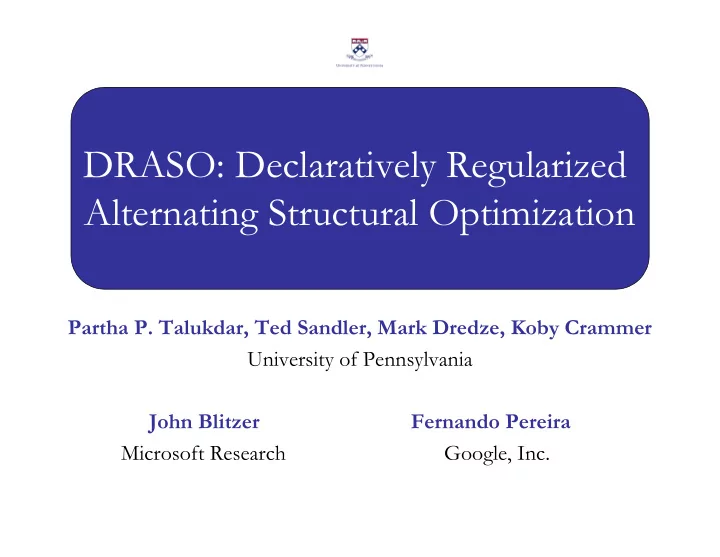

DRASO: Declaratively Regularized Alternating Structural Optimization Partha P. Talukdar, Ted Sandler, Mark Dredze, Koby Crammer University of Pennsylvania John Blitzer Fernando Pereira Microsoft Research Google, Inc.
Learning in Text and Language Processing • Supervised learning algorithms perform very well but labeled data generation is expensive and time consuming. • Unlabeled data is abundant: exploited by Semi- Supervised Learning (SSL) Algorithms. • Can we inject prior knowledge into SSL algorithms to make them more effective?
Alternating Structural Optimization (ASO) • ASO (Ando & Zhang, 2005) is a semi-supervised learning algorithm. • ASO-based algorithms have achieved impressive results: – Named Entity Extraction (Ando & Zhang, 2005) – Word Sense Disambiguation (Ando, 2006) – POS Adaptation (Blitzer et al, 2006) – Sentiment Classification Adaptation (Blitzer et al., 2007)
Supervised Training in ASO • Standard supervised training: • Supervised training in ASO: Learned from unlabeled data
How does ASO work? 1. Given a target problem (e.g. sentiment classification), design multiple auxiliary problems . 2. Train auxiliary problems on unlabeled data. 3. Reduce dimension of the weight vector matrix. Let be this shared lower dimensional transformation matrix. 4. Use to generate new features for training instances. Learn weight for these new features (along with existing features) using labeled training data.
Auxiliary Problems for Sentiment Classification Running with Scissors: A Memoir Title: Horrible book, horrible. Auxiliary Problems This book was horrible. I read half of it, Presence or absence of frequent suffering from a headache the entire time, words and bigrams: and eventually i lit it on fire. One less copy don’t_waste, horrible, suffering in the world... don't waste your money. I wish i had the time spent reading this book back so i could use it for better purposes. This book wasted my life
Step 2: Training Auxiliary Problems For each unlabeled instance, create a binary presence / absence label (1) The book is so repetitive that I (2) An excellent book. Once again, found myself yelling …. I will another wonderful novel from definitely not buy another. Grisham Binary problem: Does “ not buy ” appear here? • Mask and predict auxiliary problems using other features • Train n linear predictors , one for each binary auxiliary problem
Using Prior Knowledge in ASO • Many features have equal predictive power. • e.g. presence of excellent or fantastic in a document is equally predictive of it being a positive review. • Can we constrain the model so that similar features get similar weights (not necessarily exact)? • Answer: Locally Linear Feature Regularization (LLFR) (Sandler et al., 2008)
Feature Similarity as Prior Knowledge Domain Knowledge: • Neighboring features in lattice-structured data (e.g., images, time series data) often provide similar information. • lexicons: tell us which words are synonyms
Model Feature Similarities with a Feature Graph Features Edges encode prior knowledge j i is similarity of feature i to feature j
Regularization Criteria Because we believe features are similar to neighbors, we shrink weights toward neighborhood mean. w l w k w i w m w p Prefer each weight to be a locally linear (convex) combination of its neighbors.
Regularization in Auxiliary Problem Training • ASO Loss + • DRASO Loss + where
What is the effect of this new regularizer? • Use of SVD in ASO is not just a matter of choice: it follows from the derivation . • The new regularizer (in DRASO) results in a different eigenvalue problem (derivation is in the paper) which can be efficiently solved. • The eigenvalue problem in DRASO is a generalized version of the one in ASO, the two are same when M = I .
Experimental Results • Book reviews from Amazon.com (Blitzer et al., 2007) • Prior knowledge was obtained from SentiWordNet (Esuli & Sebastini, 2006). • Manually selected 31 positive and 42 negative sentiment words from ranked SentiWordNet lists. • Each word was connected to its 10 nearest neighbors.
Comparing Learned Projections
Conclusion • We have presented a principled way to inject prior knowledge into the ASO framework. • Current work: Application to other problems where similar regularization can be useful (e.g. NER).
Thanks!
Recommend
More recommend